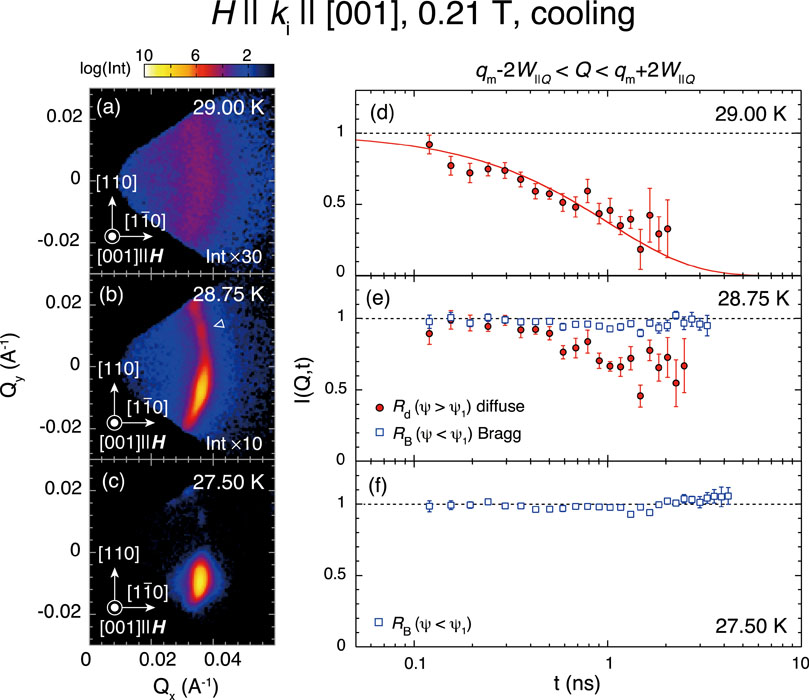Neutron Resonance Spin Echo Measurements on the Magnetic Skyrmion Lattice State in MnSi
Nakajima Group
Magnetic skyrmions are vortex-like spin objects, which can be regarded as topological defects composed of magnetic moments in a magnetic material [1]. They were discovered in a small phase pocket in the vicinity of the critical temperature in chiral cubic magnets; previous small-angle neutron scattering (SANS) [2] and Lorentz transmission electron microscopy [3] measurements have revealed that the magnetic vortices are arranged to form a triangular lattice on a plane perpendicular to an applied magnetic field. It is also reported that the magnetic skyrmions can be driven by flowing an electric current [4]. These observations show that magnetic skyrmions behave like particles once they are formed, while it remains unclear how the particle character emerges upon the phase transition from the paramagnetic (PM) phase to the skyrmion lattice (SkL) phase.
In the present study, we investigate the PM-to-SkL transition in an archetypal skyrmion compound MnSi by means of neutron spin echo (NSE) spectroscopy [5], which is suited for probing diffusive dynamics with the time scales of the order of pico- to submicroseconds. Actually, spin fluctuations in MnSi were studied by means of polarimetric and ferromagnetic NSE measurements [6], in which the Larmor precession of polarized neutron spin is utilized for detecting very small changes in neutron velocity upon quasi-elastic scattering processes. However, neither the polarimetric nor ferromagnetic NSE is suited for the SkL phase. The former is limited to zero-field measurements. Although the latter is applicable for in-field measurements, the non-collinear spin arrangement of the SkL leads to mixing of spin-flip and non-spin-flip scatterings, which depolarizes the neutron spins. We thus employ neutron resonance spin echo technique, specifically the modulation-of-intensity-with-zero-effort (MIEZE) method, in which the intermediate spin correlation function I(Q,t) = S(Q,t)/S(Q,0), where S(Q,t) is the temporally Fourier transformed dynamical structure factor, is obtained not from the final neutron spin polarization after experienced the precessions mentioned above, but from beating patterns appearing in intensities of scattered neutrons as a function of time. Since the MIEZE signals are independent of the spin state of scattered neutrons, this technique is suited for measuring magnetic scattering in a magnetic field [7].
In Figs. 1(a)-1(c), we show typical SANS patterns measured in a magnetic field of 0.21 T at the VIN ROSE instrument in the materials and life science experiment facility in J-PARC. We observed a ring-like diffuse scattering pattern at 29 K, which is slightly above the critical temperature of 28.8 K (Fig. 1(a)). This indicates that a short-range isotropic spin correlation is developing in the sample. As the temperature is lowered, a Bragg peak emerges and coexists with the ring-like diffuse scattering (Fig. 1(b)). Finally, the diffuse scattering completely disappears and only the Bragg peak remains at 27.5 K (Fig. 1(c)). We obtained I(Q,t) profiles of the diffuse and Bragg scattering components as shown in Figs. 1(d)-1(f). The I(Q,t) profile at 29 K shows a decay, which is well described by a single-exponential decay function, revealing that the magnetic moments involved in the diffuse scattering are fluctuating with a characteristic time of 1 ns. By contrast, no temporal decay of the spin correlation is found at 27.5 K (Fig. 1(f)). At the intermediate temperature where the Bragg and diffuse scattering coexist, the I(Q,t) profile for the diffuse component still shows a decay, while that for the Bragg peak is approaching unity. This demonstrates that the isotropic spin fluctuations with short-range spin correlations coexists with static SkL domains near the boundary between the PM and SkL phases. We also analyzed the I(Q,t) values as a function of azimuthal angle, and concluded that an aggregation of the magnetic skyrmions upon cooling leads to orientational disorder of the small SkL domains. This picture is consistent with the particle-like character of the magnetic skyrmions. The present results also show that the MIEZE-type NSE at VIN ROSE is a powerful tool to study spin dynamics of magnetic skyrmion systems, for which measuring spin dynamics in low-Q regions in a magnetic field is essential.
References
- [1] N. Nagaosa and Y. Tokura, Nat. Nanotechnol. 8, 899 (2013).
- [2] S. Muhlbauer et al., Science 323, 915 (2009).
- [3] X. Z. Yu et al., Nature 465, 901 (2010).
- [4] X. Z. Yu et al., Nat. Mater. 10, 106 (2011).
- [5] T. Nakajima et al., Phys. Rev. Research 2, 043393 (2020).
- [6] C. Pappas et al., Phys. Rev. Lett. 102, 197202 (2009).
- [7] J. Kindervater et al., Phys. Rev. X 9, 041059 (2019).

